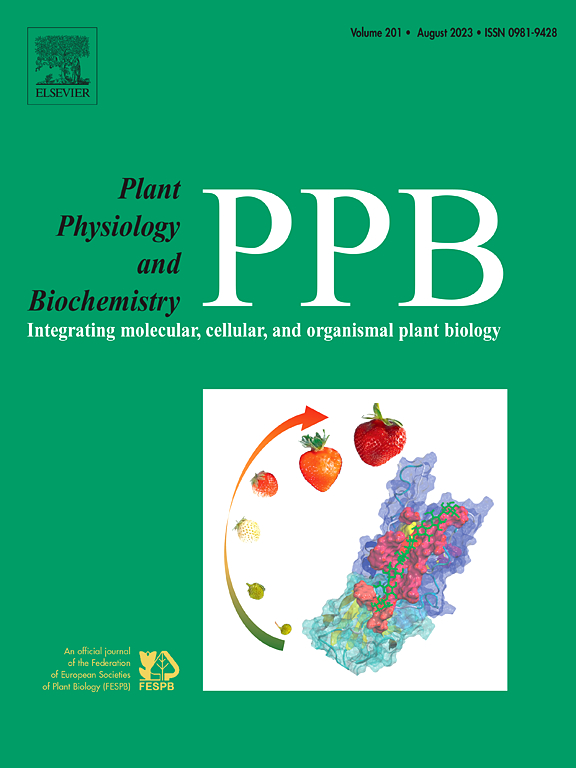Molecular mechanisms of nitric oxide regulating high photosynthetic performance of wheat plants in waterlogging at flowering
IF 6.1
2区 生物学
Q1 PLANT SCIENCES
引用次数: 0
Abstract
Nitric oxide (NO) positively contributes to maintaining a high photosynthetic rate in waterlogged-wheat plants by maintaining high stomatal conductance (gs), mesophyll conductance (gm), and electron transport rates in PSII (J). However, the molecular mechanisms underlying the synergistic regulation of photosynthetic characteristics during wheat waterlogging remain unclear. Pot experiments were conducted with two cultivars: Yangmai15 (YM15: high waterlogging-tolerance capacity) and Yangmai24 (YM24: conventional waterlogging-tolerance capacity). The 2 cm waterlogging depth treatment (WL), exogenous spraying of NO every two days in the WL treatment (WLsnp), and suitable soil water content treatment (CK) were established during the flowering stage for eight consecutive days. RNA-seq, weighted gene co-expression network analysis (WGCAN), and protein interaction analysis were performed on the 8th day to screen key genes that maintain high photosynthetic performance in waterlogged-wheat plants. The results indicated that cultivar YM24 and YM15 contained 10411 and 10582 differentially expressed genes (DEGs), respectively. The WL treatment had obviously higher DEGs than the WLsnp treatment compared to the CK treatment. Based on the WGCAN method, the DEGs were clustered into eight modules and correlated significantly with the four photosynthetic parameters mentioned above (P < 0.05). Only the DEGs in the ivory module (571) enriched the photosynthetic pathways among the eight modules. In the ivory module, 10 hub genes, including TaB1274F11.29-1, TaT6H20.190, TaOSNPB_100100300, TaLHCB, TaPSAG, TaCAP10B, TaFAD7A-1, TaCAB3C, TaT27G7, and TaF24G24.140, were screened using the co-expression network method because the genes exhibited similar variation trends with gs, gm, or J across the three water treatments and both cultivars. TaLHCB and TaCAP10B exhibited significant linear relationships with the three parameters of gs, gm, and J (P < 0.05). Consequently, TaLHCB and TaCAP10B genes are defined as waterlogging-resistance genes due to the synergistic regulation of photosynthetic characteristics in waterlogging. Both genes were significantly down-regulated in the WL treatment compared to CK treatment in both cultivars. However, there was no significant difference between WLsnp and CK treatments for the genes in the cultivar YM15. These results suggest that the positive effects of spraying NO with high waterlogging resistance capacities are linked to maintaining high expression levels of key genes and obtaining high photosynthetic characteristics during waterlogging, particularly for cultivars with high waterlogging resistance.
求助全文
约1分钟内获得全文
求助全文
来源期刊
CiteScore
11.10
自引率
3.10%
发文量
410
审稿时长
33 days
期刊介绍:
Plant Physiology and Biochemistry publishes original theoretical, experimental and technical contributions in the various fields of plant physiology (biochemistry, physiology, structure, genetics, plant-microbe interactions, etc.) at diverse levels of integration (molecular, subcellular, cellular, organ, whole plant, environmental). Opinions expressed in the journal are the sole responsibility of the authors and publication does not imply the editors'' agreement.
Manuscripts describing molecular-genetic and/or gene expression data that are not integrated with biochemical analysis and/or actual measurements of plant physiological processes are not suitable for PPB. Also "Omics" studies (transcriptomics, proteomics, metabolomics, etc.) reporting descriptive analysis without an element of functional validation assays, will not be considered. Similarly, applied agronomic or phytochemical studies that generate no new, fundamental insights in plant physiological and/or biochemical processes are not suitable for publication in PPB.
Plant Physiology and Biochemistry publishes several types of articles: Reviews, Papers and Short Papers. Articles for Reviews are either invited by the editor or proposed by the authors for the editor''s prior agreement. Reviews should not exceed 40 typewritten pages and Short Papers no more than approximately 8 typewritten pages. The fundamental character of Plant Physiology and Biochemistry remains that of a journal for original results.

 求助内容:
求助内容: 应助结果提醒方式:
应助结果提醒方式:


